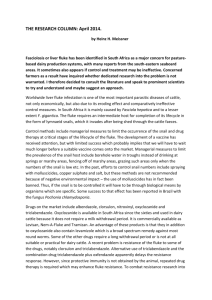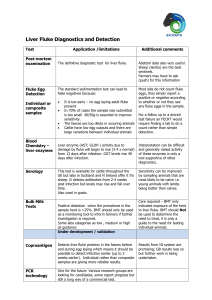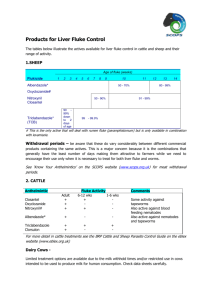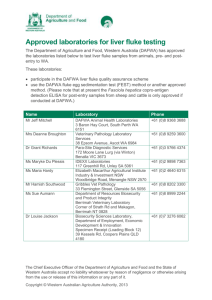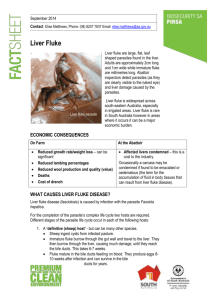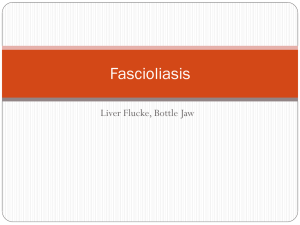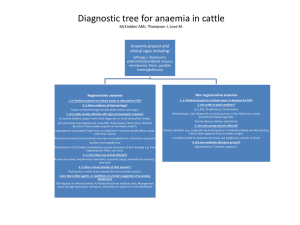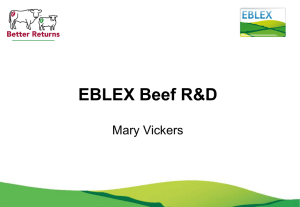Guidance for Liver fluke control
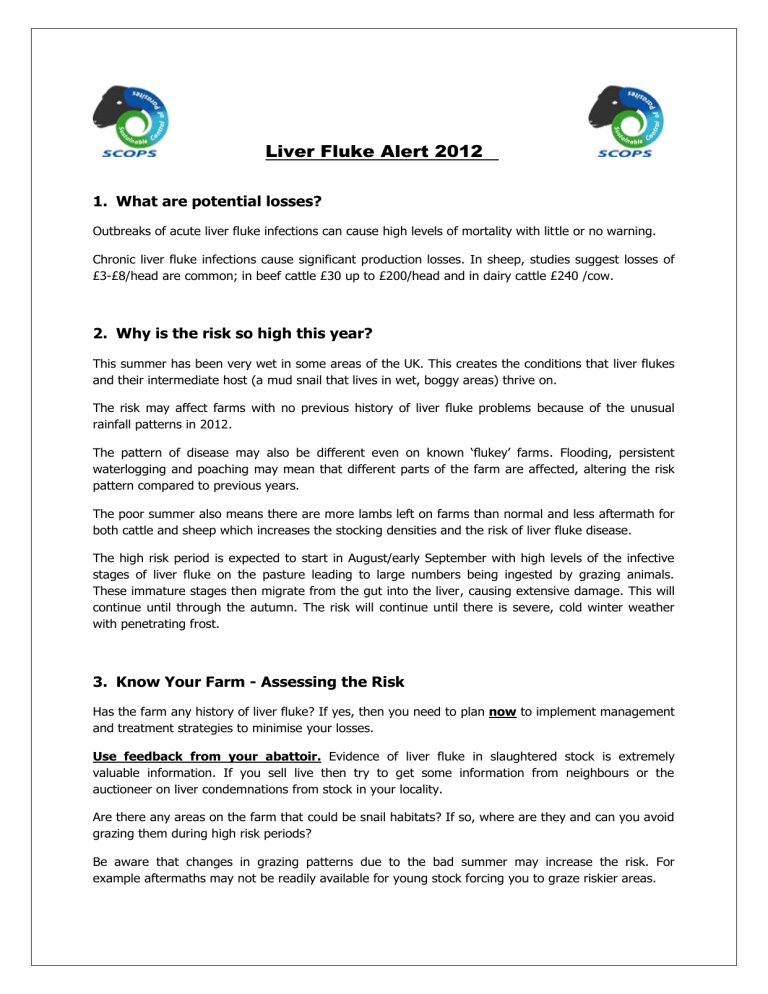
Liver Fluke Alert 2012
1.
What are potential losses?
Outbreaks of acute liver fluke infections can cause high levels of mortality with little or no warning.
Chronic liver fluke infections cause significant production losses. In sheep, studies suggest losses of
£3-£8/head are common; in beef cattle £30 up to £200/head and in dairy cattle £240 /cow.
2.
Why is the risk so high this year?
This summer has been very wet in some areas of the UK. This creates the conditions that liver flukes and their intermediate host (a mud snail that lives in wet, boggy areas) thrive on.
The risk may affect farms with no previous history of liver fluke problems because of the unusual rainfall patterns in 2012.
The pattern of disease may also be different even on known ‘flukey’ farms. Flooding, persistent waterlogging and poaching may mean that different parts of the farm are affected, altering the risk pattern compared to previous years.
The poor summer also means there are more lambs left on farms than normal and less aftermath for both cattle and sheep which increases the stocking densities and the risk of liver fluke disease.
The high risk period is expected to start in August/early September with high levels of the infective stages of liver fluke on the pasture leading to large numbers being ingested by grazing animals.
These immature stages then migrate from the gut into the liver, causing extensive damage. This will continue until through the autumn. The risk will continue until there is severe, cold winter weather with penetrating frost.
3.
Know Your Farm - Assessing the Risk
Has the farm any history of liver fluke? If yes, then you need to plan now to implement management and treatment strategies to minimise your losses.
Use feedback from your abattoir. Evidence of liver fluke in slaughtered stock is extremely valuable information. If you sell live then try to get some information from neighbours or the auctioneer on liver condemnations from stock in your locality.
Are there any areas on the farm that could be snail habitats? If so, where are they and can you avoid grazing them during high risk periods?
Be aware that changes in grazing patterns due to the bad summer may increase the risk. For example aftermaths may not be readily available for young stock forcing you to graze riskier areas.
Check your local weather patterns ( http://www.metoffice.gov.uk/climate/uk/2012/ ) for a better understanding of rainfall in your locality. Watch out for further warnings relevant to your local area from local Vets, AHVLA Laboratory and Surveillance Centre, abattoir, markets etc.
4.
Detecting and Diagnosing Liver Fluke
Remember that damaged livers are costing you money because the animals do not perform at optimum levels Use abattoir feedback. Get into the habit of asking for information on liver rejections.
Investigate deaths. A post-mortem examination will usually give a very clear indication of the presence of liver fluke
Watch for clinical signs. These include weight loss and ill-thrift, sudden death, oedema under the chin
(bottle jaw), anaemia, abdominal pain and respiratory distress.
Use performance indicators such as ewe Body Condition Score (BCS), liveweight gains in lambs and young cattle, milk yields and scanning results.
Ask your Vet about liver fluke egg detection tests which will detect the presence of adult fluke. The
Vet can also use blood tests which indicate whether animals have been exposed to liver fluke to help with detection and diagnosis.
5.
Management Options to Minimise exposure
Avoid flukey pastures and/or wet, boggy areas within fields at peak risk periods to reduce the exposure of sheep and cattle. This may mean using temporary fencing around risky areas or in some cases avoiding whole fields or grazing areas.
Housing may be a practical option particularly for cattle to avoid re-infection post treatment.
Quarantine in-coming stock and treat if they are from a flukey area.
Monitor the risk by using fluke egg detection and blood tests
Plan ahead now to minimise the risk for next year. This includes fencing boggy areas around ponds and streams, drainage including repairs to existing systems and installation of water troughs to avoid wet areas building up around watering places.
6.
Treatment options
Use the right product for the right stage(s) of liver fluke. Check the details of the product you intend to use and ask for advice if you are not sure.
Where the risk of infection is high and you need to kill immature fluke, triclabendazole (TCBZ) is the drug of choice, unless it has been established that there are resistant liver fluke on the farm.
In this case get advice on suitable alternatives. If the risk is lower then alternatives can be used, for example in cattle that are housed, treatment can be delayed until after housing. If you are unsure get professional advice.
Be aware of the risk of re-infection if animals are put back on high risk grazing areas. Use management tactics such as moving to low risk areas, fencing off risky areas or housing. If they remain in risky areas then monitoring for infection is essential and further treatments may be needed.
In spring treat to remove adult liver fluke to reduce egg output on to pastures. Use a product that will only kill adult fluke saving those which kill immatures for the autumn.
Avoid using combination fluke and worm products unless they are necessary, to help you reduce selection for resistance in worms.
7.
Test that treatments have worked
Do a
Drench Check
– take faeces samples 3 weeks after any treatment. If this shows there are still liver fluke eggs present then you must get advice on what further tests you need to do to establish whether you have liver fluke resistant to that product. Include both cattle and sheep treatments in the drench check.
8.
Protect your flock or herd – Quarantine
•
•
Assess the risk – could new stock be coming from a flukey farm? If the answer is yes, then they need to be treated with a product that targets the right stage of liver fluke.
There are 3 reasons for Quarantine treatments depending on whether or not you have fluke on your farm:
•
It will prevent liver fluke disease and production losses in the in-coming animals.
If you have potential liver fluke habitats but no history of liver fluke problems on the farm it will minimise the risk of establishing infection on your farm.
If you already have a liver fluke problem, it will minimise the risk of introducing anthelmintic resistant (AR) fluke on to your farm.
9.
Always Use Best Practice
Dose correctly. Do not over or under dose. Be prepared to split groups if there is significant variation in the weight of animals in the group.
Don’t rely on chemical treatment alone – management tactics are an essential part of liver fluke control.
Choose the right product at the right time, check the withdrawal period.
Monitor the efficacy of any treatments administered.
Vaccinate at risk stock against ‘Black Disease’ using an appropriate clostridial vaccine (7,8, or 10 in 1).
